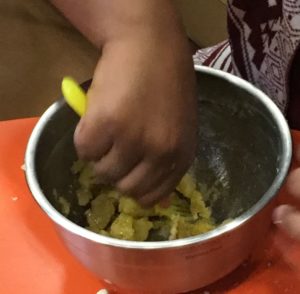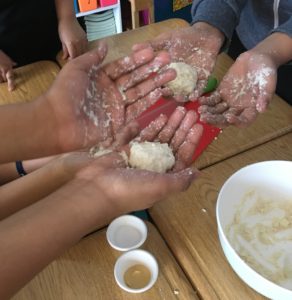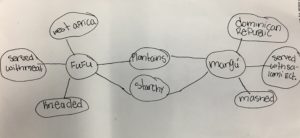
Mangú is an integral part of any Dominican breakfast. Never too salty or sweet, it serves as the starchy mashed accompaniment to fried salami, cheese, and eggs in the morning. The main ingredient of mangú is boiled green plantains, that are seasoned with a little salt, with some starchy water and perhaps a bit of butter mixed in. Though simple in ingredients, mangú’s cultural history compliments another staple, hot water cornbread. Hot water cornbread is featured prominently in cooking from the Southern part of the US, and is made from cornmeal and boiling water mixed together and fried in a pan. These two seemingly disparate food items tells a small part of the story of the African Diaspora.
In honor of the shortest month of the year (Black History Month), 5th grade students at PS 294 were able to appreciate, through culinary investigation, a small component of their identity in the richness of the African diaspora. Through exploration of food, I hoped that students would begin to recognize and value the African presence that is often latent in the cultures of Spanish speaking countries throughout Central and South America and the Caribbean.
When asked who was familiar with mangú, hands shot up in the air. Commotion filled the classroom, as students were excited to share their personal stories of mangú. The question of hot-water cornbread received only a few hands of recognition, but excitement nonetheless. Before, however, we could explore and discuss the features of mangú and hot-water cornbread, another essential question had to be addressed: what is fufu?

Students of West African descent knew exactly what fufu was, but most students were not yet familiar. In order to properly explain and appreciate these connections, students participated in a brief reading aloud. Fufu, they learned, is a staple dish of Africa, a starchy food served alongside stews or meats. It is made from a fine flour of pounded plantains and cassava, and then mixed with water over heat, and finally kneaded into a doughy-like texture. Fufu is an ancient dish whose origins can be traced to Ghana. Importantly, Fufu is the direct progenitor of both mangú and hot water cornbread (along with mofongo, hoecakes, and pancakes) traveling and adapting from the continent of Africa all the way to the Caribbean and Southern part of the United States. Fufu became Mangú in the Dominican Republic, Mofongo in Puerto Rico, and retained the same name, Fufu, in Cuba. Cassava and plantains, which do not grow in the United States, were replaced with the indigenous crop, corn, and transformed into hot water cornbread, and later, hoe cakes and pancakes.

After reading the history of these three items followed by a brief discussion, students were able to make their own hot water cornbread and mangú, both very tactile experiences, involving mashing and forming balls of dough with their hands. After the process was complete, Students ate a bite sized taste of their creations along with some fufu that I had made earlier. They were then finally able to taste the apparent similarities and differences between all three, and taste a bite of history, resilience, and innovation.
By Zahra Booth, FoodCorps Member